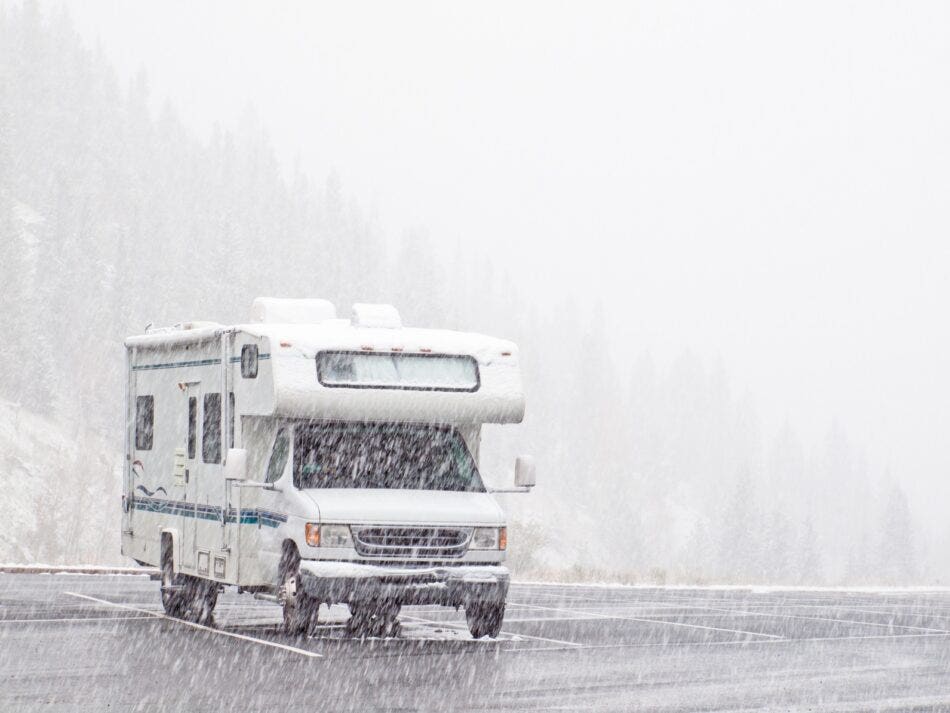Once you’ve experienced the joy of summer camping it’s tempting to extend the fun into the fall or get a head start in spring. Keep in mind you’re dealing with a different set of conditions. Whether you’re getting the most out of your camping season by starting in early spring and continuing until late fall or you’ve packed up your RV and stored it for winter freezing pipes are a concern.
Your RV’s lines are very vulnerable to the cold weather and they run the risk of freezing and bursting unless they are properly maintained. You obviously don’t want that headache and expense!
How to Prevent Freezing Lines in an RV Lines
1. Drain the tanks and pipes.
This is the single most important step you can take to preserve your RV’s lines during cold weather. An RV with water in the tanks and pipes below freezing can cause frozen pipes and potentially cause your pipes to burst (particularly during spring). This causes flooding and serious damage to your RV.
To save your RV’s storage tanks and connecting pipes from being damaged by frozen water be sure to drain it using the appropriate hose (keep black grey and white tank hoses separate) and store your RV with empty tanks.
2. Install an electric tank heater.
But what if you want to use your RV during this kind of weather? If going dry isn’t an option for you then you should install an electric tank heater. This will let you keep your water tank full during colder seasons while keeping the water from freezing. Simply stick the electric heater to the bottom of your tank heater.
3. Check your Insulation.
Good insulation helps protect your pipes from losing heat which is essential when you’re camping in spring fall and winter. Inspect your RV for exposed pipes the most vulnerable to freezing. Insulating tape is cheap and easy to use simply wrap the tape repeatedly over and around all exposed water pipes. There are more effective extensive and expensive insulation options on the market but this is a basic first step.
4. Be ready for inclement weather.
Be prepared in case the weather turns cold. You can increase the insulation of the holding tank by placing a pile of towels over it. This will add an extra layer which works with your existing insulation to prevent freezing. Don’t forget to keep yourself warm either!
But what if your pipes freeze despite your best efforts? Do your best to unfreeze the pipes. While a plumber is the best bet if you’re camping that’s not going to be an option. Below are our tips to unfreeze your pipes – take care to do it as gently as possible to avoid damage.
Tips for Unfreezing an RV’s Lines
1. Heat tape.
Though called heat tape the gadget is actually a wire that you can use to heat up your frozen pipe. First examine the frozen pipe for cracks – you can’t use heat tape if there are any. Next coil the wire around the frozen pipe and plug the wire into an electric outlet.
Heat tapes can be found at your home improvement stores. They come in different sizes so ensure you pick the right size for your needs. This is a good method to use because it slowly thaws the pipe thus reducing wear and tear on the pipe.
2. Camper heater.
Heat the frozen sections with a camper heater. While this isn’t the most effective method it may be your only option. Do not leave a heater unattended as they can cause a fire – handle them with care and watch over them!
3. Plumber’s torch or hair dryer.
If the frozen water pipes are made of steel or copper you can use a plumber’s torch to melt the frozen water in the pipes by directing the torch’s heat to the frozen sections of the pipe. Obviously this can best be done at home not while you’re at a campsite. If the pipe has breaks or cracks do not use a plumber’s torch.
If you’re uncomfortable using a torch or don’t have one available a hand-held hair dryer also works. Hold it to the pipe and slowly move up and down the length of the frozen section. Make sure you are standing on dry ground and the hair dryer is properly plugged in.
If you have suffered damage to your RV or just need some guidance on what your RV policy covers give your broker a call and they’ll help you through the process.

